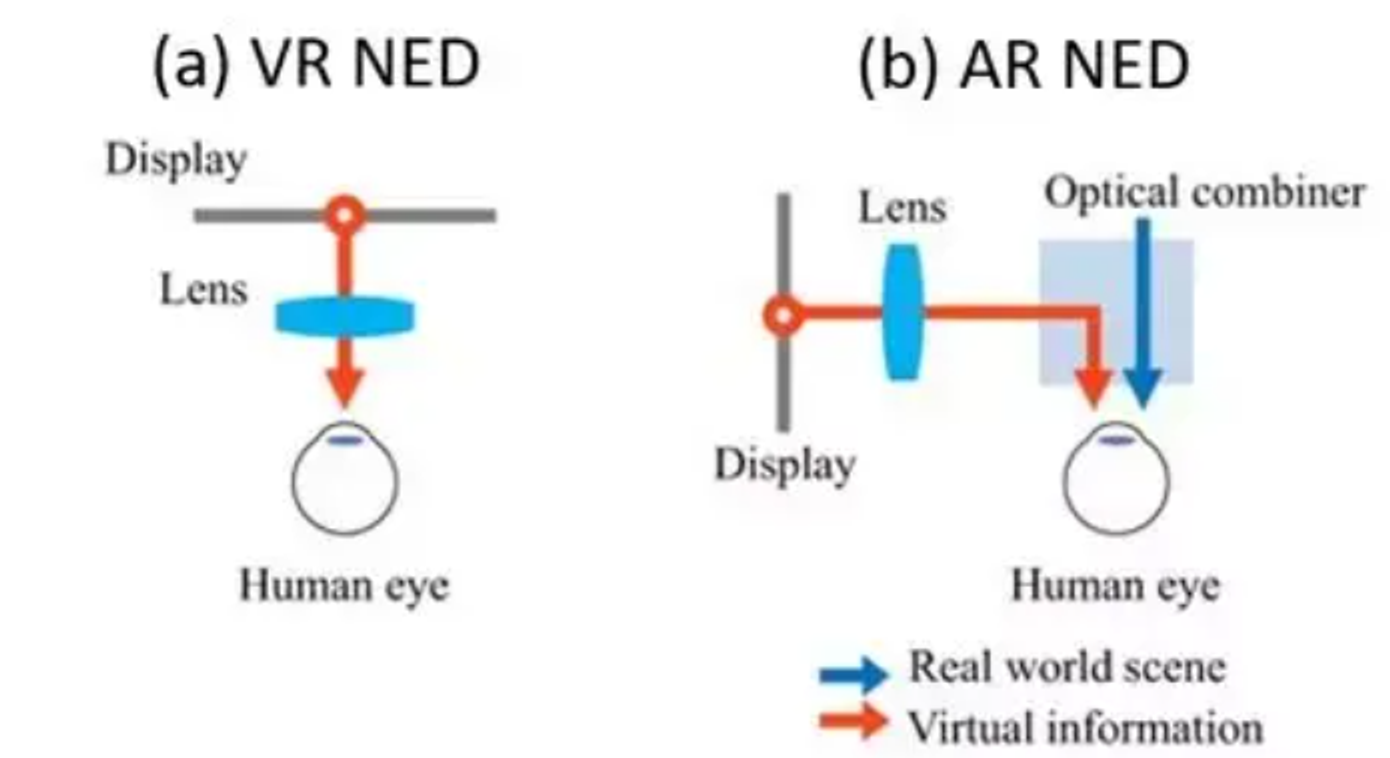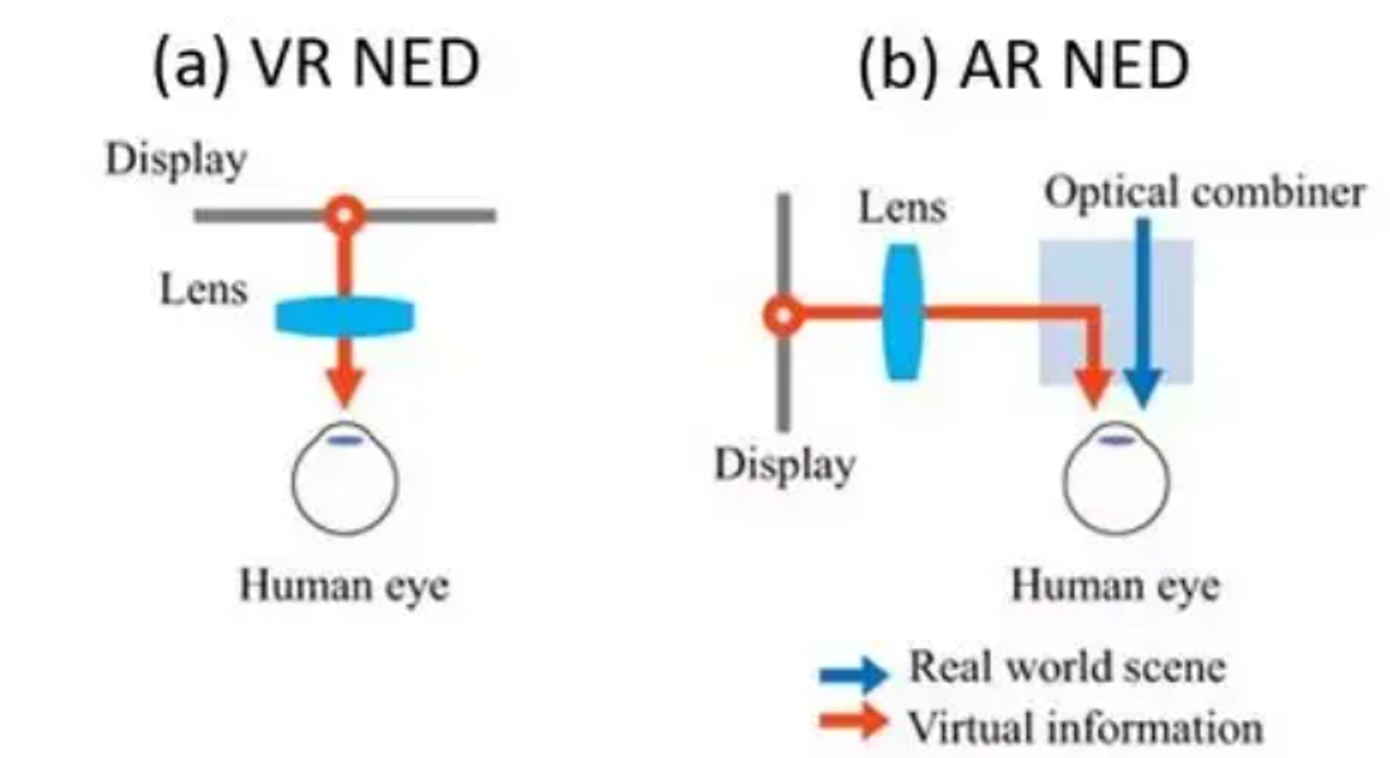Introduction
Augmented Reality (AR) and Virtual Reality (VR) are widely concerned fields of science and technology in recent years. Their near-eye display systems project the pixels on the display to the human eye through a series of optical imaging elements to form a distant virtual image.
The difference is that AR glasses need to see through, both the real world and virtual information, so the imaging system can't stand in front of the line of sight. This requires the addition of one or a group of optical combiners, through the form of "stacking", the virtual information and the real scene are integrated into one, complemecting and "enhancing" each other.
 The optical display system of AR devices usually consists of a miniature display screen and optical components. To sum up, the display system used by AR glasses on the market at present is a combination of various micro displays and optical components such as prisms, freeform surfaces, BirdBath, and optical waveguides. Among them, the difference of optical combiners is the key part to distinguish AR display systems.
The optical display system of AR devices usually consists of a miniature display screen and optical components. To sum up, the display system used by AR glasses on the market at present is a combination of various micro displays and optical components such as prisms, freeform surfaces, BirdBath, and optical waveguides. Among them, the difference of optical combiners is the key part to distinguish AR display systems.
A miniature display used to provide display content for the device. It can be self-emitting active devices, such as light-emitting diode panels like micro-OLED and the now popular micro-LED, or liquid crystal displays that require external light sources (including transmission LCDS and reflective LCOS), There are also digital micromirror arrays (DMD, the core of DLP) and laser beam scanners (LBS) based on micro-electromechanical systems (MEMS) technology.
Principle
In AR glasses, in order to transmit light without loss or leakage, "total reflection" is the key, that is, light in the waveguide like a snake through the back and forth and forward without transmission.
In brief, to achieve total reflection, two conditions need to be met:
(1) the transmission medium, (the waveguide material)needs to have a higher refractive index than the surrounding medium (as shown in Figure n1> n2);
(2) The incident Angle of light entering the waveguide needs to be larger than the critical Angle θc.

After the optical machine has completed the imaging process, the waveguide couples the light into its own glass substrate, which is transmitted to the front of the eye and released by the principle of "total reflection".
In this process, the waveguide is only responsible for transmitting the image, and generally does not do any "work" (such as zoom in and out, etc.) on the image itself. It can be understood as "parallel light in, parallel light out", so it is a separate element independent of the imaging system.
This characteristic of optical waveguide has great advantages in optimizing the design and beautifying the appearance of the head wear. With waveguides as the transmission channel, the display and imaging system can be moved away from the glasses to the top or side of the forehead, which greatly reduces the optical system's blocking of the outside world's view and makes the weight distribution more ergonomic, thus improving the wearing experience of the device.
Classification
In general, optical waveguides can be divided into Geometric Waveguide and Diffractive Waveguide.
- Geometric waveguide is the so-called array optical waveguide, which achieves image output and eye movement frame expansion by stacking array mirrors.
- Diffractive optical waveguides mainly include Surface Relief Grating manufactured by lithography technology and Volumetric Holographic Grating manufactured by holographic interference technology. HoloLens 2, Magic Leap One belongs to the former, holographic grating light guide is the use of holographic grating elements instead of relief grating.
Advantages
- Increase the scope of the eye tracking frame to accommodate more people, improve mechanical tolerance, and promote consumer products - increase the eye tracking frame through 1-D and 2-D pupil expansion technology.
- Side-mounted imaging system, unobstructed view and improved weight distribution - waveguide lenses act as fiber optic cables to transmit images to the human eye.
- The shape is more like a traditional eyeglass, which facilitates iterative design - the waveguide shape is generally a flat, thin glass sheet, whose contour can be cut.
- Offers the possibility of "true" 3D images-multiple layers of waveguide sheets can be stacked on top of each other, each providing a virtual distance.
Disadvantages
- Relatively low optical efficiency - light is lost in the process of coupling in and out of the waveguide and transmission, and the large eye movement frame reduces the brightness of the single point output.
- Geometric waveguide: Cumbersome manufacturing process leads to low overall yield.
- Diffraction waveguide: Diffraction dispersion leads to image "rainbow" phenomenon and halo, non-traditional geometry optics, high design threshold.
Read more

Introduction: Welcome to the fascinating world of mixed reality, where the lines between the physical and digital realms blur, providing immersive experiences beyond imagination. In this blog, we...

In the ever-evolving world of AR, VR, and MR, two key players hold the key to seamless light transmission: optical fibers and waveguides. Both guide light efficiently using total internal reflect...



Leave a comment
This site is protected by hCaptcha and the hCaptcha Privacy Policy and Terms of Service apply.